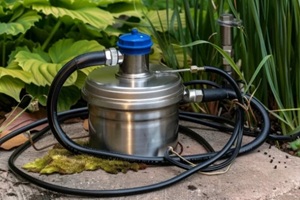
Purchasing a home is one of the biggest investments you will make, and in Maryland, that often means inheriting private well and septic systems. These hidden parts of a property can quietly serve a household for decades when maintained correctly, or they can create unexpected expenses if overlooked during the buying process.
Every responsible homebuyer should treat due diligence as non-negotiable, which means examining public records, checking for prior issues, conducting water tests, and hiring qualified inspectors before agreeing to close.
Pulling Records Before You Visit the Property
The first step when buying a home with a well and septic system is to review the history of the installation. For wells, request the Well Completion Report and any associated permits from the seller and the county health department.
These documents contain details about depth, casing, grout, yield, pump information, and construction dates. In Maryland, well reports are held through local Approving Authorities and state archives, so access is possible even for older systems.
Septic systems require a similar review, so ask for the as-built drawings, original permits, percolation test results, and any documentation that shows the approved replacement area. Maryland regulations mandate that each property have a designated reserve area for future system replacement.
Many counties make this process easier through online request portals. Baltimore County, for instance, offers a convenient digital form for both well and septic records.
Verifying Layout and Setbacks
Maryland’s onsite code requires specific separation distances between wells and septic systems to protect groundwater. If the septic system is in an unconfined aquifer, the minimum separation is 100 feet; if it’s in a confined aquifer, the minimum distance is 50 feet. An inspector should confirm aquifer type during both the record review and site evaluation.
Once records are in hand, the next step is sketching the property layout. The sketch should include the well, septic tank, pump chamber if present, distribution box, and drainfield.
Any additional features such as driveways, sheds, pools, and property lines should also be marked. The sketch benefits buyers by offering a clear visual reference, and at the same time, it is formally required as part of Maryland’s property transfer inspection documentation.
Inspecting Well Construction and Performance
The condition of the wellhead often provides one of the clearest outward signs of how healthy and properly maintained the well system truly is.
Maryland requires sanitary well caps and a casing that terminates above ground level. Inspectors should look for a tightly sealed cap, conduit that is properly secured, and grading that directs water away from the well.
Performance is another major consideration. Counties often use performance criteria to determine if a low-yield well can still meet household needs with the help of storage. For example, Baltimore County requires new systems to deliver 500 gallons in two hours, once per day.

Buyers benefit from a flow test that measures pressure and yield, providing a snapshot of how well the system is functioning. Equipment checks should include pump age and type, pressure tank size and settings, pressure switch cut-in and cut-out, and any treatment units or bypass plumbing.
Ordering Water Tests That Matter in Maryland
Annual well testing is recommended through Maryland’s Be Well Wise program, but for a home purchase, buyers should go further. Water should be sampled at both the kitchen cold tap and a raw-water tap before treatment. Always use a Maryland-certified laboratory for accuracy.
Core Tests Every Buyer Should Request
- Total coliform and E. coli, which help identify septic influence or surface intrusion
- Nitrate and nitrite, which can signal contamination from septic or agricultural sources
- pH and total dissolved solids (TDS), both of which play a role in water safety as well as the long-term durability of plumbing
Additional Maryland-Specific Testing
- Lead and copper, particularly in older homes with legacy plumbing
- Iron and manganese, minerals often found in local aquifers that may create taste concerns or visible staining around fixtures
- Radionuclides such as gross alpha and radium in central and northern Maryland where geology increases risk
- Radon in water, especially in Zone-1 radon counties or granitic terrains
- PFAS near military facilities, airports, or industrial sites
- VOCs if the home is near old fuel stations or industrial areas
Loan programs such as FHA, VA, and USDA often require specific potability tests. Buyers should consult with their lender early to confirm testing requirements and align their sampling plan with both health standards and financing conditions.
Requesting a Maryland-Compliant Septic Inspection
Maryland law requires property-transfer septic inspections to be performed by professionals who have completed state-approved training.
The inspection process includes a file search with the county, an interview with occupants, a physical system evaluation, and a written report with a system sketch; dye testing alone doesn’t satisfy these requirements. For homes that have sat empty or experienced minimal water usage, it’s wise to conduct a hydraulic load test to evaluate system performance.
During the inspection, the septic professional should check:
- Tank structure, lids, risers, and watertight seals
- Inlet and outlet baffles or tees, essential to maintaining proper wastewater flow and preventing system disruption
- Signs of infiltration or abnormal liquid levels
- Distribution box integrity and even flow to trenches
- Evidence of surfacing effluent or backups
- Proper operation and maintenance of any BAT (Best Available Technology) nitrogen-reduction unit, which is required in certain Chesapeake Bay Critical Areas
Acting On Test Results and Inspection Findings
When bacteria are detected, remediation might include correcting intrusion sources, shock chlorination, flushing, and retesting. Long-term protection may involve adding a UV disinfection system certified under NSF/ANSI 55 Class A.
Elevated nitrate or nitrite can be addressed with point-of-use reverse osmosis or whole-house anion exchange. For lead and metals, treatment units with NSF/ANSI 53 or 58 certification are appropriate.
More advanced issues such as radium or uranium require ion exchange or reverse osmosis, guided by county and Maryland Department of the Environment recommendations. PFAS treatment may involve reverse osmosis or specialized carbon systems.
Have Complete Confidence in Your Home Purchase

Taking the time to understand a property’s well and septic systems can make all the difference in avoiding unexpected expenses and protecting your water supply. A thorough inspection, clear records, and proper testing provide the insight you need to buy with confidence and plan for long-term maintenance.
For more than three decades, Tri-County Pump Service, Inc. has offered professional services in well pumps, water quality treatment, septic maintenance, and plumbing throughout Maryland, Virginia, and West Virginia.
If you’re preparing to buy a home or need professional guidance for your current property, we are ready to help. Call us today at 1-(301)-783-0038, schedule service online, or use our contact form to connect with our team.



